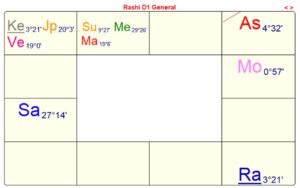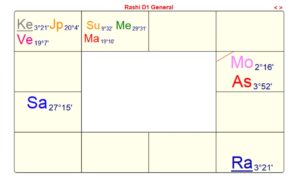
J. Robert Oppenheimer was a man of many facets and contradictions: delicate aesthete and robust horseman; aristocratic-eccentric and polymath genius; tireless activist and political scapegoat. However, he is remembered in history for one thing above all — unleashing the incredible power locked inside the atom. In their Pulitzer Prize-winning 2005 biography American Prometheus: The Triumph and Tragedy of J. Robert Oppenheimer, Kai Bird and Martin Sherwin compare the famous physicist to the Greek who stole the dangerous secret of fire from the gods — and underwent eternal punishment for his transgression. Oppenheimer’s resonance with this mythical figure’s travails was not lost on the physicist himself.
Interest in Oppenheimer’s complex legacy has surged recently in connection with Christopher Nolan’s eponymous film, largely based on Bird and Sherwin’s biography. His birth chart of course is of interest to astrologers, even with the complication of uncertain birth time. He was born on April 22, 1904 in New York, NY. AstroDatabank lists the birth time as 8:15 a.m., rated DD (for “dirty data”), but with no source for the time, casting further doubt on its reliability. (1) The uncertainty makes it a candidate for chart rectification for which the toolkit of Jyotisha may be well utilized.
In this article, we will compare the 8:15 a.m. chart with an alternate birth time, 10:32 a.m. Full arguments for each of the times (with their different Ascendants) is beyond the limits of this piece, but even an abbreviated rectification discussion sheds light on both the methods of Jyotisha and on one of the most paradoxical lives of the 20th century.
How could a man who read Baudelaire in French and the Bhagavad Gita in the original Sanskrit, a “scientist who writes like a poet and speaks like a prophet,” become a key contributor to the mass devastation of Hiroshima and Nagasaki? (2) Moreover, how did an eccentric theoretical physics professor manage to execute one of history’s most complex top-secret projects, one involving 130,000 people, 30 sites, and $2.2 billion ($30–$50 billion in today’s cost) over the course of three years?
His chart — in tandem with the Bhagavad Gita itself — holds clues to both questions, as we seek to reverse engineer Oppenheimer’s life events and find a birth chart commensurate with his remarkable story.
We begin with consideration of the Jyotisha chart for 8:15 a.m. with Gemini rising.

Chart #1: J. Robert Oppenheimer, 8:15 am EST
Mercury, the Ascendant lord, is strong thanks to support from its dispositor (or landlord), Mars, who sits in Aries, his own sign. A strong rising lord strengthens the whole chart, giving the native an ability to make use of the other beneficial yogas (planetary combinations) present in the chart.
The yogas here include two in the Mahapuruśā class, or “great person,” yogas. Such combinations are formed when one of the five true planets — e.g., excluding the nodes, the Sun and the Moon — sits in an angular house in its own sign or sign of exaltation. (We will see that some schools of thought also extend this yoga to strong planets posited in trinal houses.) Such a planet can exert its influence in a powerful way and become a major source of strength for the native.
Oppenheimer’s 8:15 a.m. chart boasts two such Mahapuruśā yogas, one for Jupiter and one for Venus, who both occupy the 10th house (of karma or action) with strength (due to the planets being in their own sign and exaltation, respectively). Appearing close to the Midheaven, in the highest of the twelve houses, these yogas suggest Oppenheimer’s pre-eminence in his chosen field. The intrinsic nature of Jupiter and Venus as significators of teaching underscores his role as teacher and savant, as well as highlighting his refined aesthetic-philosophical sensibility.
Meanwhile, Oppenheimer’s 2nd house, with its malefic aspects, helps explain his chain smoking and eventual oral cancer. The 2nd house represents the mouth region and is a place where we can read oral addictions.
Remarkable in such a frail-looking and delicate man, it is natural to wonder about his bravery and surprising physical prowess. Oppenheimer was noted for physical courage, as demonstrated by his vigorous horsemanship and bold sailing exploits. In the Gemini rising chart, we see his courage in the great strength of the Sun, 3rd-house lord, exalted in the 11th house of gains and success.
That 11th house, full of fire and brimstone, draws the eye. Mars joins the Sun here in Aries along with the rising lord, Mercury. This combination, an especially incisive version of Budhaditya yoga, would help give the native a brilliant and penetrating mind, especially as planets in the 11th aspect the 5th house of intelligence.
Other 11th-house indications include peer groups, society, and achievement of goals. In these areas we can also see the influence of the fiery planets; Oppenheimer kept powerful company (Sun represents government and Mars is a military commander) and had lofty goals, many of which he eventually accomplished. (Mars helped with this despite his status as a natural malefic planet as he protects the house he owns. To quote a teacher from our lineage, “even a thief looks after his own den.”) (3)
Looking at this influential and blazing planetary grouping, one wonders how this array of planets might perform in the 10th house, the apex of the chart and the abode of karma, e.g., our actions in the world. If “Oppie” were born an hour or two after the listed 8:15 a.m., the 11th-house planets would shift to the 10th house.

Chart #2: J. Robert Oppenheimer, 10:15 am EST
In this proposed rectified chart, the 10th house is marked by the same fiery malefic planets Mars (powerful in its own sign) and the Sun (powerful by both exaltation and directional strength), along with Mercury. This potent combination provides the sheer firepower one would expect for a career in high energy physics and nuclear research, as well as the potential for karmic difficulties resulting from such actions. (Malefics are said to cause the native to “sin” or perform wicked deeds in those areas of life corresponding to their natal positions.) Overall, this is a massively powerful 10th bhava (house), as befits a man with such world-shaking influence that he could legitimately quote Krishna, who says in the Gita, “Now I am become death, destroyer of worlds.”
Does the 10:32 a.m. chart hold up to scrutiny in other respects? As in the earlier chart, the rising lord (the Moon) is doubly strong (in its own sign and a key divisional chart). Here, however, both Ascendant lord and the Ascendant itself are afflicted by a massively strong Saturn (strong in its own sign and by directional strength). Moon in its own sign of Cancer brings out the creative personality and the mojo of the charismatic leader that we find in Oppenheimer during the Manhattan Project, while the Saturnian influence is evident in Oppenheimer’s thin and bony build, his nervous disposition, and his delicate health. Nevertheless, this Ascendant has the strength to utilize the many powerful combinations (yogas), which the Cancer rising has in spades.
The proposed rectification gives Oppenheimer no fewer than four Mahapuruśā yogas — Rucaka, Shasha, Hamsa and Malavya yoga, formed by Mars, Saturn, Jupiter and Venus, respectively. (Please note: this analysis is based on an oral tradition that holds that Mahapuruśā or “Mahapuruśā-like” yogas can also be formed by planets in trinal houses). The Rucaka and Shasha yogas are especially strong, as both repeat when counted from the Moon and the Sun, while the Hamsa and Malavya yogas both repeat from the Moon. Such yogas have a compounding quality: the more of them present, the larger the scale and impact of the individual. Notably, however, the Mahapuruśā yogas formed by natural malefics Mars and Saturn give an edgy, somewhat rough cast to the greatness they bestow; for instance, Mars’s Rucaka yoga lends, along with power and bravery, an arrogance to which Oppenheimer’s enemies would have been all too happy to testify.
In terms of further combinations of pre-eminence, we see a special kind of Maharaja yoga formed by the 9th lord occupying the 9th, while the 10th lord occupies the 10th — a combination also seen in such luminaries as Warren Buffet and Harrison Ford. In this chart Jupiter and Mars create this rare combination. Jupiter and Venus form another Maharaja yoga of the 4th lord and 9th lord, while Moon and Saturn add a Dharma Karma Adhipati yoga by mutual aspect. Even more than the Gemini Ascendant chart, the Cancer Ascendant chart is studded with powerful yogas.
Oppenheimer’s intellectual prowess is accentuated in the Cancer rising chart through the configuration of the Budhaditya and Saraswati yogas. Mars’s special aspect to the 5th house of intellect and discernment (Mars’s own sign) provides the sharpness in Oppenheimer’s thinking. (4) The 5th house gets another supporting aspect with a strong Jupiter reinforcing the intelligence and the quick-but-logical decision making required of a scientific leader and an administrator. Meanwhile, the 3rd house (a house of physics) is a perfect home for the out-of-the-box, innovative but disembodied Rahu (North Node). This nodal placement perfectly describes a groundbreaking theoretical physicist who proved mediocre (to put it mildly) at the experimental side of his chosen science.
In terms of Oppenheimer’s career, the placement of Saturn, Mars, and Mercury in angular houses give technical ability and a capacity for scientific endeavor, while Mars, Sun, Moon, and Jupiter affecting the 1st and 10th bhavas form strong combinations for politics, government, leadership, and public communications, areas in which Oppenheimer became deeply embroiled alongside teaching and research.
The Cancer chart is also consistent with the presence of powerful hidden enemies, such as his secret nemesis, Lewis Strauss. Hidden enemies are read from the trik houses (houses 6, 8, and 12), especially the 6th. Here, we see that the 6th-lord Jupiter loses its planetary war with Venus, while Jupiter is afflicted by Saturn.
Dynamic analysis, based largely on these Vimshottari daśā periods and sub-periods, is a powerful tool in Jyotisha. A brief glance at his biography reveals that Oppenheimer’s Saturn daśā — which ran until he was a little over the age of 20 — brought serious difficulties as well as physical and mental health struggles. Saturn’s influence on the Moon, which in the Cancer chart represents both the body and the mind, is a confluent factor. (5) Saturn is followed by Mercury for 19 years in the daśā sequence. Mercury, the 12th and 3rd lord in the Cancer chart, is not free from challenges, but eventually did improve his life since Mercury, as ruler of communication and intellect, is a key participant in the Budhaditya and Saraswati yogas. Oppenheimeir graduated and became a professor at the University of California, Berkeley during this period.
Next, his seven-year Ketu (South Node) period which runs from 1941 to 1948 coincides with the timing of the Manhattan Project. This makes sense when we consider the planets that shadow planet Ketu mimics — due to its placement in the horoscope, namely Jupiter, Venus, and Saturn — all massively powerful yogic planets in the life of this extraordinary native. These planets bring about the themes of the houses that they own and the nakshatras (Vedic asterisms/stars) they inhabit. Ketu period hence becomes the most consequential period where the aforementioned yogas operate, creating the history which makes Oppie a key figure of the 20th century.
The exercise of rectification provides endless opportunities for scrutiny and fine detail. For the sake of brevity, we will forego discussion of several interesting areas (such as the women/romantic relationships in his life) in order to take a closer look at a seminal one: Oppenheimer’s moral conscience and the paradox of his involvement with the bomb.
Oppenheimer was terribly conscience-ridden about his role in the Manhattan Project — tormented, one could even say — and became a campaigner against the development of the (even more powerful) H-bomb. Yet despite his acute moral sense, and his intense and complex feelings about his role on the world stage, he never judged himself to be guilty in a simplistic or black-and-white manner. Like Arjuna in the Bhagavad Gita, he must have felt that he did his righteous duty — his dharma — even when it could hardly be fathomed. Indeed, Oppenheimer cited the Gita as second, only after Baudelaire, on his list of most personally important books. He resonated with the Indian classic’s moral vision, which foregrounds the idea that we must play the part we have been given in the great pageant of life and surrender our responsibility for what may follow, for that is not ours to claim. For Oppenheimer, such a perspective was not the cop-out that it might sound like to Western ears, but a kind of amor fati, love of one’s fate, and even a kind of humility — that is, accepting that we stay true to our purpose.
This isn’t to say that ego and ambition were absent during Oppenheimer’s Manhattan Project days, or that he was a perfect paragon of dharma (righteous duty). But he was driven in no small part by a sense of duty. At first, this compelled him to help defeat the Nazi threat. Later, after he became disillusioned with the workings of power, the same righteous duty compelled him to reverse course as he became an outspoken advocate against the development of yet more powerful weapons like the H-bomb. Remarkably paralleling Arjuna in the Gita, Oppenheimer found himself duty-bound to accept a destructive dharma, but also to fight against yet greater destruction when it did not support his righteous duty.
Returning to themes of dharma and duty, it’s significant that two of the planets which represent dharma for Cancer Ascendants are linked in Oppenheimer’s chart as Jupiter is aspecting the Moon; Jupiter is also the general significator for dharma and is located in one of the main houses from which dharma is read (the 9th). Yet Oppenheimer’s sense of dharma or righteous duty was at odds with his ambition, a fact we can see from the planetary war between dharmic Jupiter and Venus the 11th lord of material gains, as planets must be less than one degree apart for a planetary war to occur. It is only in the Cancer Ascendant chart that this war takes place in the 9th house of dharma, a fact that goes a long way toward explaining the deep, perhaps irreconcilable conflicts Oppenheimer felt regarding his work. While on the subject of the planetary war, it is also notable that his lengthy political battles took place during the daśā period of warring Venus which ran in the years 1948 to 1968.
On the whole, the Cancer chart reveals a native who was destined to play a very significant role in changing the course of humanity, someone with great inner tension and paradoxically — someone who warred with himself, but who ultimately sought to act nobly (one of the indications of Punarvasu, his lunar nakshatra).
If our assertion about Cancer Ascendant is correct, the exact birth time can potentially be dialed in to close to the minute using the divisional chart methods of 20th-century South Indian Jyotishi Seshadri Iyer. Based on applying Iyer’s work to Oppenheimer, we propose a birth time of 10:32 a.m. Although further technicalities are beyond our scope here, and we will never know for certain the exact time of his birth, the evidence in the divisional charts for 10:32 a.m. squares well with our modern-day Prometheus.
Oppenheimer is interesting to us, as many see ourselves in his struggle with the power of free will, especially when it seems to conflict with ethical ideals or our sense of righteousness. At some point, we are all confronted with such moral dilemmas, albeit much smaller in consequence than those faced by Oppenheimer. We look for answers in various places per our inclinations. Some turn to scripture, as Oppie did. It seems that in so doing he was able, if not to resolve, then at least to live with his momentous choices.
Robert Oppenheimer’s life highlights the essential tensions and contradictions of being human. We each contain multitudes, per Walt Whitman, an entire cosmos within. Yet Oppenheimer, scientist and humanist, reminds us: while we are all subject to the forces of fate or karma, we are not mere pawns in the gods’ game. It is possible to embody opposites and to bear even the burden of a world-shaking role while remaining fully human and open to the beauty and the mystery of life.
photo: NorthCountryPublicRadio.org
Footnotes:
1. J. Robert Oppenheimer, April 22, 1904; 8:15 a.m. EST, New York, NY (40N43 74W000. Rodden rating: DD. AstroDatabank.
2. Kai Bird and Martin J. Sherwin, American Prometheus: The Triumph and Tragedy of J. Robert Oppenheimer, Vintage Books, 2006.
3. Hart De Fouw and Robert Svoboda, Light on Life: An Introduction to the Astrology of India, Penguin, 1996.
4. In Jyotish, Mars, Saturn, and Jupiter are considered to cast “special aspects,” in addition to the normal 7th-house aspects cast by all the planets. Mars aspects the 4th and 8th houses (counted inclusively) from his position.
5. Confluence refers to several factors pointing in the same direction. When confluence for a given outcome is present, it points to relatively fixed (immoveable) karma in that area of life. In this case, Saturn’s influence on the moon combines with Saturn’s mahadaśā to give confluence to the idea of mental and physical health struggles during this period.
Author Bios

A corporate executive by profession and an electrical engineer by education, Rohit Khetarpal was born and raised in a midsize town in eastern India. He moved to the US for his Master’s degree and stayed to become a naturalized citizen. A curious stargazer from childhood, this interest alchemized to exploring Jyotiṣa. He has been studying under the tutelage of Penny Farrow since 2012. He lives in Nashua, New Hampshire with his wife and daughter. He has been doing Jyotisha (Vedic astrology readings) since 2017 and has clients across the world. He supports Penny Farrow’s “sangha” as an adjunct teacher and loves to research astrology. He can be contacted via his website www.novaastrology.com

Jonathan Hadas Edwards is a practitioner of East Asian Medicine and divination traditions, including Jyotish. His writings on astrology, acupuncture, herbalism and other topics can be found at Seeds From the World Tree; while his clinical work finds a home at jonathanhadasedwards.com. A New Yorker by birth and upbringing, Jonathan lives in rural North Carolina at Heartward Sanctuary, a center he and his wife started in service of a sane world where life and death are held sacred.

4 Comments
Super interesting !!! Thanks for this well written and fascinating study!
Glad you enjoyed it! Thanks for taking time to comment.
Any rectification by definition has to account for the natal nakshatra associated with each potential nativity. The earlier nativity has Mrigashira as the natal nakshatra, and the article described the native’s delicate build/highly sensitive persona (like a deer) and his propensity for keeping powerful company (both characteristics of Mrigashira).
If you want to make a strong case for the later chart, it isn’t enough to place a powerful trifecta in the 10th House. The chart must speak to a natal nakshatra of Purnavasu, the sign of achieving second chances. Purnavasu is not a strongly mental sign and is considered a passive nakshatra along with an accompanying contented personality. Although it is strongly visionary and is associated with professions having to do with the air. It’s a toss-up, but my sense is Mrigashira was likely a better fit. Mrigashira is popular yet cautious and discriminating about who they mingle with. Oppenheimer’s wife and close associates were communists. Hmmm
Thanks for your input Monica! Fair point on the Nakshatra as a tool for rectification. Just sharing that we did consider the Ascendant as well as Moon’s Nakshatras while coming up with our proposal. A Gemini chart is still definitely a possibility and hence we offered arguments in favor of that too. On the Mrigashira/ Mrigashirsha another point that goes in favor of your suggestion is the connection with horses or dogs which is noticed in Oppenheimer’s life. There is also leaning towards affairs and liasions.
In our lineage and tradition there are some very subtle points about Nakshatras that have been shared which are not found in common literature. Taking those into account Punarvasu has some advantage. Punarvasu has a connection to war or military endeavors ( symbol is quiver of arrows), in addition it is said that the native would generally be a technocrat who is capable of leading large enterprises.
Playing devil’s advocate one can argue that since the Moon’s Nakshatra would be in Punarvasu for the earlier birth time, and Moon’s Nakshatra carries a lot of weight in native characteristics, a gemini rising is still not out of question.
The clincher for us was the planetary war between two benefic planets in the 9th house of “Dharma”. It’s such a huge paradox of Oppenheimer’s life and noticing that in the chart made us lean in the direction of Cancer.
However, we really appreciate your input and the points you have brought forward. This is the fun of rectification, it makes for rich conversations and meritorious debates and we sharpen our astrological analysis as a side benefit.